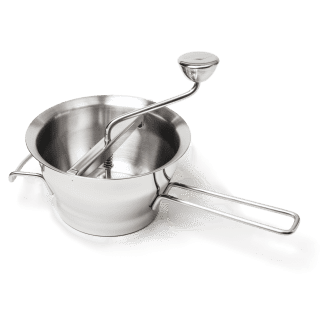A food mill simultaneously grinds and strains foods. To use it, you turn a crank, and a spring-loaded blade presses the fruit or vegetable through a perforated disk, extruding a smooth, dense puree and leaving most skins and seeds behind in the hopper. Because you often don’t need to peel or seed produce before milling, the food mill can save a lot of time and effort. We wanted to know which food mill was the most stable, efficient, and easy to use, so we tested a range of models, using them to make mashed potatoes, applesauce, raspberry coulis, and tomato sauce.

Each mill we tested has at least three interchangeable disks with different-size perforations for fine, medium, and coarse purees. While the perforation sizes and patterns varied from model to model, puree quality was not an issue. All the models produced smooth, even-textured purees with each of their disks and handled each type of produce equally well—the tomato sauce, coulis, and applesauce made with each mill were great, although all mills ground some potato skin into the mashed potatoes.

For almost every task, even the slowest models were faster and more efficient than the peelers, ricers, wooden spoons, blenders, and strainers we’d otherwise use for those preparations. It took us 11 minutes to peel 1½ pounds of tomatoes by hand and put them through a blender, making a seedy, aerated sauce, but it took just 2 to 4 minutes in the food mills to process the same amount of unpeeled tomatoes into a skinless, nearly seedless sauce.
Still, some machines worked more quickly than others. The main factor in determining speed was the force exerted by a small spring at the center of the mill. Each time you set up a food mill, you compress the spring by locking the bar it’s attached to into the hopper. When compressed, this spring keeps the rotating blade close to the perforated disk and delivers the force necessary to extrude the produce as you turn the crank. Slack springs didn’t generate enough force to mill the food quickly, but springs that were too tightly coiled pushed through unwanted berry and tomato seeds and required more muscle power to compress, making it more difficult to set up the mills and break them down. The best mills had medium-tight springs that were easy to install and provided just enough force to process produce efficiently without seeds passing through.
Problems also arose in terms of comfort, as larger mills were heavier to lift and thus less ideal for sessions in which we needed to process multiple batches of food. Others had handles that became uncomfortable to grip after just a few minutes.
Stability also proved important. Models with legs that extended out from the bottom of the hopper were the most stable, provided that they extended far enough to reach the sides of wide cooking vessels such as Dutch ovens, as they allowed the whole mill to sit securely on top of a bowl or pot. Models that hooked onto the sides of the cooking vessel tended to wobble or rock during use, requiring more effort from the user to stabilize them. That said, mills with handles and hooks that were covered in rubbery material were more secure than ones without, as they gripped cooking vessels more readily and thus were less prone to sliding around. Deeper models often sank so low within the pot that larger volumes of mashed potatoes and applesauce built up underneath, forcing us to repeatedly clear the purees with a spatula to make room for more.

We liked our winner, the Cuisipro Deluxe Food Mill, for its comfortable, rubber-coated handles; large capacity; and smooth processing. It wasn’t quite as stable as we would like, but its grippy hook and handle helped it sit fairly securely in a wide variety of cooking vessels. We liked how its large capacity enabled us to process a large quantity of potatoes, apples, or berries in one go, but its size also meant that its base sometimes sat in the resulting puree. Despite this, it was easy to clean and comfortable to use.
The Tests
- Make mashed potatoes
- Make applesauce
- Make raspberry coulis
- Make tomato sauce
- Have six test cooks use and rank
- Wash by hand or put through dishwasher 10 times
How We Rated
- Performance: We awarded more points to food mills that worked efficiently and held back a higher percentage of seeds and skins when making mashed potatoes, applesauce, raspberry coulis, and tomato sauce.
- Ease of Use: We evaluated how heavy the machines were, how comfortable the handles were, how smoothly the cranks turned, and how easily the machine could be set up, dismantled, and washed.
- Stability: We awarded more points to mills that sat securely on top of cooking vessels and did not rock, tip, or jerk during processing.
- Legs (not hooks) to stabilize food mill
- Comfortable, grippy handle
- Lightweight
- Medium spring force on blade














